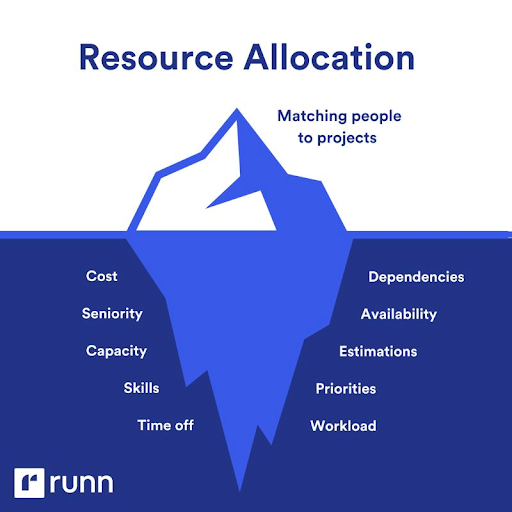
Iceberg Ahead? What Not to Forget When Allocating Resources to Projects
Managing project delivery for an agency is no mean feat. There is always something on your to-do list. You proactively manage risk, while accepting the fact that you can’t account for everything. No two days are the same.
Resource allocation is just one of the many factors that impacts your organization’s ability to deliver high-quality projects. But do you treat it like a priority? Does your resource allocation strategy look meticulous, or does it sound more like – “Depends on who’s free”?
It may be just another task on the list, but rushing to allocate resources to projects without considering the details could land you in hot water. Not only can it damage the team’s morale and risk jeopardizing client relationships, it can also chip away at project profit margins and stunt your agency’s ability to grow.
So, let’s dig into the details – and deal with the iceberg ahead.
Allocating resources to projects
The resource allocation process is an essential pillar of project management. After all, your agency’s most crucial assets are your people. If you want to execute projects successfully and keep your clients happy, you need to master the art of scheduling the right people to do the right tasks at the right time.
With that said, let’s break down what effective resource allocation in project management involves:
- Taking the project plan into consideration during resource planning, with particular attention to the project scope and task dependencies that limit the flexibility of the project timeline
- Monitoring your team’s availability during resource scheduling
- Knowing the capacity of your available resources when lining up future projects
- Identifying which skilled resources are required, and flagging if the same resources are needed for simultaneous project tasks
- Creating a solid strategy for short-term and long-term resource allocation for project execution
It is a lot to keep in mind, but you’re not on your own. In today’s digital world, you can find resource management software that offers a helping hand to improve human resource allocation strategies. They can help you track your resource availability, utilization, and capacity, so you can make better decisions across the entire project.
The tip of the iceberg?
The trouble is when it comes to project resourcing, simply identifying who is available to work or not doesn’t go far enough. To come up with a solid resource plan for a project, there are other considerations that have to stay in mind – but you may have to look a bit closer at the situation.
This phenomenon is known as the Iceberg Principle: the existence of information buried beneath the most obvious set of details.

When it comes to data and metrics about your project resources, the iceberg principle also warns us not to rely too heavily on aggregated data, as we can lose touch with the individual differences between members of our resource pool.
Let’s look at a couple of examples:
Skills
While there may be several members of the team who can do a particular task, it’s unlikely that their abilities and expertise are exactly the same.
For example, you may have three front-end developers with availability in their schedules. But their relative proficiency with different programming languages is likely to vary. They may have areas where they excel, and areas where they lack experience.
To make the right call as to who should work on a project, you’ll need a more granular view of their skills and competencies in order, as well as a thorough understanding of the technicalities of the project at hand.
Cost
Variable rates can easily cause resourcing headaches. It makes sense to charge more for a senior developer’s time than a junior developer’s time, for instance. But what if a junior developer isn’t available during a critical point during a project timeline? You might have to assign a senior to the work just to get it over the line, but that’s going to increase the project cost.
So what do you do? You could charge the client extra for having a senior developer on their project, or you could keep quiet about the issue and absorb the cost. But then the project will cost more to deliver than expected.
Why you need to get resource allocation right?
Resourcing details like the examples above may lie beneath the surface, but it’s easy to see how they can impact your agency’s profitability. When you get resource management right, it can help your agency run efficiently, delivering high-quality projects on time, while ensuring that you are paid properly for your work.
But the positive effects extend beyond these top-line benefits. Proper resource allocation will also:
- Reduce duplicate job functions and under-utilization that can arise from unclear roles
- Increase accountability, both individually and as a team
- Prevent the need for overtime and heavy workloads, saving your team from stress and burnout
- Improve quality of work delivered, because employees are not handling an unreasonable workload
- Encourage more precise communication between project managers and employees, as well as among team members
- Boost employee morale, as booking PTO will be more straightforward
- Establish better relationships within the workplace
How to ensure you consider all factors when allocating resources?
The entire process of project resource management depends on an effective resource allocation process that takes all factors into account – from availability, to skill proficiency, to workload, and more.
Here are three tips to ensure you see beneath the surface when planning your resource allocation:
- Use a resource management solution
Keeping track of all the details can be overwhelming if you’re working with a manual system. Fortunately, all-in-one project management software can replace that pile of paperwork, post-its, and spreadsheets.
By working with an innovative platform like Runn, you can get a birds-eye-view of your entire agency’s resources, your employees’ availability, utilization rates, and even billable hours, making it easy to keep track of your team.
- Plan with certainty
With a resource allocation tool in place, you can set up your projects well in advance, confident that you have an accurate picture of your resources’ availability ahead of time. A platform like Runn will give you detailed information about your team, including their scheduled leave, which projects they are assigned to, and their corresponding workload.
You can bring this information together in a resource calendar, so you can plan for upcoming work without the hassle of assigning and reassigning team members.
- Sort resources by other factors
By sorting your resources according to their skills, level of seniority, and relevant experience, you can easily account for these hidden factors that might otherwise be missed.
With Runn, for example, you can assign skills to each team member, along with a scale indicator of how experienced they are in that area. When it comes to assigning tasks, project managers can filter by the skills and experience they require, to formulate an efficient resource allocation strategy across multiple projects.
Conclusion
You can have reams of project artifacts and documentation to hand in, but if you don’t have the people to work on the project, nothing will get done. Resource planning should never be an afterthought – in fact, it’s critical. But you need clear oversight of a complex web of factors in order to do it justice.
Using resource management software makes sure you don’t get overwhelmed while trying to keep all these factors pinned down. So, allow yourself a vital helping hand: set yourself up for success when allocating resources to projects by using a platform that does the hard work for you.























